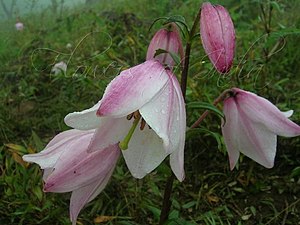Lilium mackliniae
| Lilium mackliniae | ||||||||||||
|---|---|---|---|---|---|---|---|---|---|---|---|---|

Lilium mackliniae in situ, India |
||||||||||||
| Systematics | ||||||||||||
|
||||||||||||
| Scientific name | ||||||||||||
| Lilium mackliniae | ||||||||||||
| Sealy |
Lilium mackliniae , also called Manipur lily , is a species from the genus of lilies ( Lilium ) in the Asiatic section . The species was first discovered in 1946 by Frank Kingdon-Ward , who named it after his wife's maiden name. It is the state flower of Manipur .
description
Lilium mackliniae is a perennial herbaceous plant that reaches heights of up to 115 centimeters, 10 to 15 centimeters of which grows underground. The plant is greenish to reddish-brown, hairy and leafy from just above the base. The broad, egg-shaped bulbs are round and around 4.5 inches wide and 4 inches high, the scales are pale yellow and 2 to 3 inches wide.
The stem forms roots above ground. The lanceolate leaves are about 10 cm long and 1 cm wide. They are freely distributed around the stem.
It blooms in the rainy months of the south-west monsoon from June to July with a single flower or up to 5 nodding, bell-shaped flowers in a panicle . The hermaphrodite flowers are threefold and about 7 cm in diameter. The basic color of the flowers is white to light purple, the outside of the flower is coated in purple. The bracts are oval to lanceolate. Anthers and pollen are brown. The seeds mature in seed pods.
The number of chromosomes is 2n = 24.
distribution
Lilium mackliniae grows on grassy mountain slopes at altitudes of 1730 to 2590 m.
The species is endemic to the Sirhoi Mountains in the district Ukhrul in Manipur in India . However, there are also said to be deposits in Bangladesh and Myanmar .
use
The species has been cultivated, but is hardly common in gardens. However, she won the prestigious Merit Prize of the Royal Horticultural Society Flower Show in London in 1948 .
Culture
A legend of the native Tangkhul Naga says that the lily is the ornament of the goddess Philava , who inhabits the Kashong peak in the Sirhoi. For this reason the lily should not thrive anywhere else but in these mountains, but this part of the legend has since been refuted.